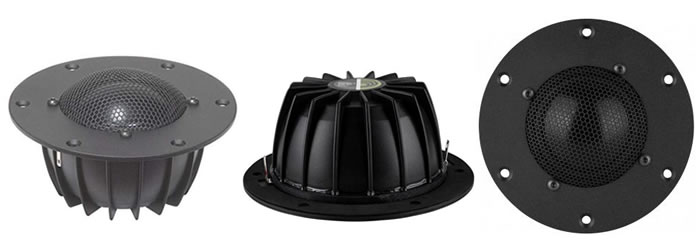|
Dayton RS52AN-8 The Dayton RS52AN is a rather unusual midrange driver. Instead of a cone, the diaphragm is a 2″ dome made of aluminum. As in all metal diaphragms, there is a severe breakup when it loses control. The plot below is the RAW response of the RS52AN. The breakup can be seen at about 12kHz. For best results, the cone breakup must be treated. Failing to do so will result in horrendous treble. Dayton RS52AN RAW Frequency Response
Dayton RS52AN Impedance
Dayton RS52AN Harmonic Distortion
The RS52AN harmonic distortion is -60dB below the fundamental. Measurement in Fig 3 is of the RS52AN with a bandpass filter with corner frequencies of 800Hz (HP) and 4kHz (LP) both at 12dB/oct. Dayton RS52AN Cumulative Spectral Decay (CSD)
Fig 4 is the CSD of the RS52AN with a bandpass filter shown in Fig 3. Measurement is made with Rise Time = 0.1ms, Time Range = 1.0ms, Window = 1.5ms (667Hz) and Total Slices = 100. The CSD shows the RS52AN displaying minimal artifacts in it’s working range.
|
|||
| RS52AN Frequency Response
High Pass of the RS52 is at 800Hz (24dB/oct). Low Pass is by Synergy at 4,500Hz (18dB/oct). No passive or active EQ applied. The RS52 cone breakup peak at 12kHz is down 18dB. This will not interfere with the tweeter’s response. |
 (Fig 1) RS52AN Response (No Smoothing, mic at 1 meter XT25 axis, 5 msec gating) |
||
| Crossing RS52AN with XT25SC90
Fig 2 shows the RS52 Low Pass and XT25SC90 High Pass with the Synergy crossover set at 4,500Hz. The Blue plot is the summed response of the midrange and tweeter. The XT25SC90 is wired in Reversed Phase. |
 (Fig 2) Response of RS52AN and XT25SC90 (No Smoothing, mic at 1 meter XT25 axis, 5 msec gating) |
||
| Crossing 830869 | RS52AN | XT25SC90
The Blue plot in Fig 3 is the Peerless 830869 woofer with 800Hz (24dB/oct) Low Pass. The Black plot is the RS52 High Pass also at 800Hz (24dB/oct). |
 (Fig 3) High Pass and Low Pass responses of 930869, RS52AN and XT25SC90 |
||
 (Fig 4) Summed Response (No Smoothing, mic at 1 meter XT25 axis, 5 msec gating). Disregard measurement below 500Hz. |
|||
| Summed Response
Fig 4 is the summed response of the 830869 woofer, the RS52AN midrange and the XT25SC90 tweeter. Disregard measurements below 500Hz. My room is interfering with the accuracy. The flatness is incredible. Apart from a small blip at 4.5kHz, it is virtually ruler straight all the way out to 10kHz. Bear in mind that No Smoothing was applied to the plot. Further to that, there was no EQ, whether actively or passively. Tweeter wired in Reversed Phase. |
|||
| Sound Quality
The realism of the mids with the RS52AN is astounding. It’s not simply the clarity and transparency. It’s fast. The attack of the voices and instruments must be heard to believe. There’s also the micro details that adds depth to the mids. Most of the time, these get lost but not with the RS52AN. This speaker can best be described as revealing. It will show everything, good, bad and ugly. A fully passive version using the RS52AN is at Falcon-II. This page was last modified on 19 Feb, 2018. |
|||

October 4, 2016HIFI DRIVERS

 Fig 2 – Impedance Sweep of RS52AN
Fig 2 – Impedance Sweep of RS52AN Fig 3 – 2nd (RED) and 3rd (VIOLET) Harmonic Distortion.
Fig 3 – 2nd (RED) and 3rd (VIOLET) Harmonic Distortion. Fig 4 – CSD of Dayton RS52AN
Fig 4 – CSD of Dayton RS52AN